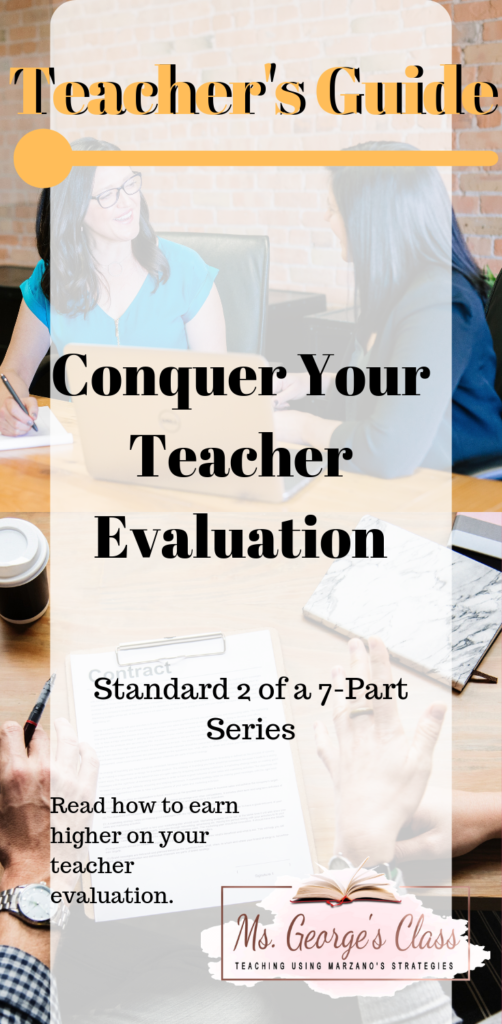Ohio Standard 2: Content
This is a 7-part series. You are reading Standard 2 of the 7-part series.

What an honor it is to be recognized for your hard work. You come to work early, you stay late, you help out with every program, and you still have time to learn about every student and write engaging lesson plans. You may get a “job well done” statement or a small token from a parent, but the best gift is earning accomplished on your teacher evaluation. You have documented classroom behavior, read the latest professional books, and now all that hard work pays off through this recognition. In the state of Ohio, teachers can earn four types of evaluation ratings: ineffective, developing, skilled, and accomplished. The goal is to reach accomplished. Reaching accomplished status can be challenging, especially if you have a detail-oriented evaluator, but it’s not impossible. Become familiar with the Ohio Standards for the Teaching Profession and you will be on your way to a higher evaluation score.
Where to Start with the Ohio Teacher Evaluation?
In the state of Ohio, educators are evaluated on several teaching criteria. The evaluation rubric has seven areas of evaluating teacher’s performance or standards. This article will cover one of the areas in a systemic, analytical manner to help teachers improve their scores on the evaluation. The seven areas of evaluation are Standard 1 students, Standard 2 content, Standard 3 assessment, Standard 4 instruction, Standard 5 learning environment, Standard 6 collaboration and communication, and Standard 7 professional responsibility and growth. You may find more information about each standard in the book Standards for Ohio Educators. This a great source to understand each standard and conquer your goal for earning an accomplished teacher score. Since the information is so intensive, purchasing a binder to keep all your documentation is strongly suggested.
First, when analyzing teaching standards, having the rubric available will assist you in understanding the performance assessment. You can click on this link to get the Ohio Department of Education Teacher Performance Evaluation Rubric (this is now a Word Document, and you click on the link at the bottom of the page). Marzano has included a supplement to the teacher evaluation model that is aligned with the Ohio State Standards. Also, the book, Standards for Ohio Educators, is where I gathered most of my information. The Ohio Department of Education has included this book on their website; click here to view the book. The rubric is organized differently from the standards. They are organized in this manner:
| The Focus of Teaching and Learning | The Conditions for Teaching and Learning | Teaching as a Profession |
| Standard 1: Students | Standard 5: Learning Environment | Standard 6: Collaboration and Communication |
| Standard 2: Content | Standard 7: Professional Responsibility and Growth | |
| Standard 3: Assessment | ||
| Standard 4: Instruction |
What is Standard 2: Content?
Under the category “The Focus of Teaching and Learning” is Standard 2: Content. According to the Standards for Ohio Educators book, Standard 2: Content states, “Teachers know and understand the content area for which they have instructional responsibility” (19). In the short narrative summary associated with Standard 2, it says that effective teachers have deep understanding of content, vocabulary, and processes. Teachers have to understand the standards of their subject matter and connect the skills and content to prepare students for real-life experiences. The information presented has to be meaningful and relevant. There are five elements under this standard. They are:
2.1 “Teachers know the content they each and use their knowledge of content-specific concepts, assumptions and skills to plan instruction.
2.2 Teachers understand and use content-specific instructional strategies to effectively teach the central concepts and skills of the discipline.
2.3 Teachers understand school and district curriculum priorities and the Ohio academic content standards.
2.4 Teachers understand the relationship of knowledge within the discipline to other content areas.
2.5 Teachers connect content to relevant life experiences and career opportunities,” (19).
Analyzing the Elements and Indicators
Standard 2.1 evaluates the teacher’s understanding of their content area, instruction, and the development sequence of students’ learning. The goal is to earn accomplished within each element, and if you don’t, you should still rank skilled. There are seven indicators for this element (use this link to view the book Standards for Ohio Educators). The indicators cover teachers identifying research, using their knowledge, sequencing learning, integrating different viewpoints and theories, extending their content knowledge, planning instruction, and supporting the growth of other educators from the teacher’s deepened knowledge. One suggestion is to document all your efforts to understand your content area and any coursework you take that is related to teaching. Within your lesson plans, reference the newest best practices and include current concepts in your content. Also, take a professional development that can enhance your knowledge in your content area and keep your transcript or certificate from the course. At my school, we have Teacher Building Teams (TBT) and department meetings. Prior to the meetings, send out emails of articles or newfound information relating to the content area. This will serve as a documentation of the teacher supporting the growth of others.

Understanding and using instructional strategies to teach the content effectively is addressed with Standard 2.2. There are five indicators for this standard, and they cover how the teacher demonstrates frameworks and common misconceptions, engaging students within the content area, teachers adjusting the learning to ensure students understand the concepts, including content learning strategies, and evaluating strategies. Often, educators reflect on strategies that work or didn’t work in their classroom. What if you wrote down the strategy you used for the classroom and then wrote an anecdote about how it worked? This would be impressive to an evaluator. There are hundreds of strategies you can use within your classroom. This blog focuses on Robert Marzano’s strategies, and in his book The Art and Science of Teaching, there are over 300 strategies. Another book that my school promotes is Teach Like a Champion 2.0 by Doug Lemov, and there are hundreds of strategies in that book as well. As mentioned, documentation of your work is very important and can increase your evaluation level to accomplished.
Standard 2.3 addresses how the teacher understands school and district curriculum and Ohio content standards. In the indicators, words such as articulate, extend, enrich, and serve are used to describe this standard. Can you articulate the academic content standards to your students? You can show this by having an objective on the board and repeating it to your students throughout your lesson. Do you extend and enrich the curriculum by connecting the school’s, district’s, and state’s standards? Last year, I made a diagram analyzing the learning process using the common core standard and the district’s pacing guide. I explained how I used the standard to analyze the lesson into smaller pieces. You can also read my blog post about working on a pacing committee here. We took a standard and made learning targets from it. It is the same concept. You take a common core standard and analyze it into smaller learning targets. Have you worked on a pacing guide committee or assisted with writing the curriculum for your grade level or subject area? If you have, you can state your participation to earn a higher score on this standard. I have been guilty of not telling my evaluator that I have worked on several committees creating pacing guides, curriculum guides, and district-wide assessments. Don’t overlook your commitment to curriculum like I did. Document it in your evaluation pre-conference.

Have you ever collaborated with your team to create a cross-curriculum activity? Have you reviewed another subject within your classroom? If you answered yes to either of those questions, you could score higher with Standard 2.4. Standard 2.4 is about understanding the relationship with other content areas. According to the text, the proficient teacher makes “relevant content connections between disciplines” (21). To increase your score, you have to prepare opportunities for those connections with other content areas and collaboratively construct between the content areas. As an accomplished teacher, you design projects for students across content areas and lead or model collaborative instruction. You can provide emails and pictures as your documentation of collaborating with your colleagues. When I worked on a middle school TBT, we would always collaborate to create a semester project for our students. My district mandated that middle school students write one social studies and one science essay. Does your school require that students work on a cross-curriculum project? You may use the project for this category and score accomplished for a task you were required to complete.
Standard 2.5 is having the teacher connect the subject matter to real-life experiences. I remember watching a video of a language arts teacher taking the classified section of the newspaper and reading job descriptions. I tried it once, and it went well. Because of today’s technology, using a newspaper may be outdated. However, you can still design an assignment that is relevant and current with today’s modern world. The indicators for this standard use the words facilitate learning, use variety, design innovative activities, and model for other teachers. Facilitating learning about real-life situations and careers is the first level. As a teacher, if you use variety and design innovative activities that reflect practices in real life or career, you earn a higher score. To reach the accomplished level, you are modeling for other teachers to use the strategies within their own classroom. If you modeled within a small group of teachers, use that experience as documentation for your evaluation. If you designed a project that reflects real-life experiences, place the lesson within your documentation binder. Keep documentation of your work to increase your score from developing to accomplished.
What Can You Do to Earn Accomplished Status?
As teachers, we perform so many tasks and duties that we often overlook what makes us accomplished. The higher-level score for each element was a collaboration, model, support, lead, serve. When you are in a department meeting and you state support, clarity, or guidance, you are acting as an accomplished teacher. However, we overlook or forget the input, and we cheat ourselves out of increasing our evaluation score. Keep a binder that has emails, lesson plans, and contact with people relating to the content. Also, make sure you state these items during your pre-conference. You can state, “During the summer, I participated in the pacing guide committee and created pacing for the district’s seventh-grade team. Here is an email stating I was accepted as a committee member, and here is the completed pacing guide.” You can elaborate using the language from the standards book. The best advice is to be prepared during your evaluation. The hard work truly pays off when you earn the score of an accomplished teacher.

After reading this blog post, what are you going to change to be a stronger teacher? Are you aiming to be an accomplished teacher? Let me know in the comment section below.
Work Cited
Ohio Department of Education. Standards for Ohio Educators, 2007.




Leave a Reply